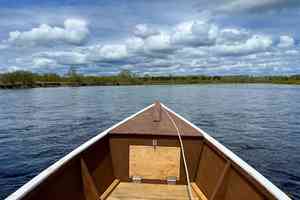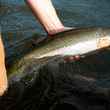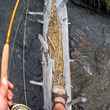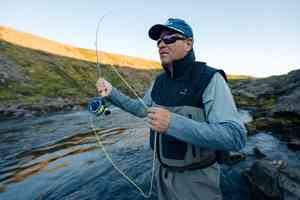Twice in my life I’ve accidentally stepped on a snake. Both encounters happened during my teen years.
The first time, I simply felt movement transmitted through my shoe’s sole, which sent a jolt through my soul, as I knew what creature was likely underfoot but had no idea of the species. It was a speckled kingsnake, who seemed no worse for wear with my foot on its back, and slithered off with my apologies.
The second victim of my inattentive stomping was a watersnake, which are often quick to bite when threatened, as I might be myself if a giant tried to step on me. I remember thinking that I must have stepped on a cable or rope and looking down to see a snake’s mouth latched onto the heavy foam uppers of my Nike Air Flight high tops. I’ve not ever been scared of snakes. However, the idea of something biting me is a bit unnerving, and a snake biting my shoe is awful close to a snake biting me. So I might have wigged out a little, maybe even screamed a little, and tried to jump away. But somehow, the snake’s coils kept it tethered within striking range and it took repeated jabs at me as I panic danced up the slippery pond bank and finally kicked the snake into some cattails.
In the years since, I’ve learned to pay more attention to where my hands and feet are placed. But since snakes make their living as masters of deception, accidents can happen. That’s why in my home state of Arkansas and parts south, I wear snake boots on overland trips in wild areas from March through early October.
Snake boots are exactly what you think, unless you’re thinking of some 80s urban cowboy scene and a pair of scaly shit kickers.
The snake boots I’m talking about are designed specifically to stop serpent fangs from reaching your lower legs and feet. They also serve as excellent shields for greenbrier, blackberry brambles, even barbed wire fences and most are advertised as waterproof. I’ve owned several pairs over the years and wore the treads off of all. They’re on my feet a lot including all of turkey season, summer deer scouting and hanging treestands, early-season squirrel hunts, and long treks through snakey woods on my way to the creek honey holes. The drawbacks have been relative comfort, questionable waterproof claims, time invested in lacing up, and more energy required to take them off. But these seem small trade-offs for a little peace of mind.
My current snake boot is the Venom from LaCrosse, a company that has been making boots since 1897. LaCrosse is best known for their waterproof hunting boots such as the Grange, Burly, Alpha Burly and, my current favorite, the Aerohead Sport. But LaCrosse has also been building snake boots for more than 20 years with the Venom as their latest design.
What Works
My snake boots of the past were plagued with a few problems. Snake boots are designed to sheath your leg from the knee down in impenetrable armor, so sacrificing comfort in the name of protection was a given. I suffered through the discomfort because even the best outcome of a timber rattler bite four miles from the truck and 40 miles from the hospital is pretty damn bad. But those frequent four-mile treks chasing gobblers over yonder hill would have been much more pleasant in a comfortable boot.
Comfort
As with all leather boots, a break-in period is required, but after only 10 or so miles of rocky trails and creek crossings in the 2.5 pound Venoms, they began to feel and act less like a medieval knight’s shin plating and more like a hybrid between trail boots and a super-supportive really high-top basketball shoe. No, I wouldn’t want to grab next in a pick-up game while shod in Venoms. But the boots had a decidedly athletic feel to them compared to snake boots in my past. Every mile since, and I think I’m around 25, the boots have softened up even more.
Another aspect of comfort is how easy it is to put the boots on and take them off. Venoms have both laces and a zipper, which makes the ordeal less an ordeal while providing a tight and somewhat custom fit.
Durability
When I say “soft,” I’m talking about flex. The boot is still tough as nails when it comes to pointy things. The secret to its toughness remains kind of secret. Behind the 1,000 Denier nylon (harder to fray than boot-standard 500 Denier nylon) and leather is a combination of what LaCrosse says is “strategically placed leather, rubber, and non-woven snake guard material.” What is “snake guard material”? I called LaCrosse to find out and learned that Snake Guard is a proprietary material in the plastics family and that’s as specific as the rep would get. But he also mentioned that it’s in a cross-hatch pattern. According to the LaCrosse rep, that cross hatching along with the unique properties of the material itself help deflect stabs.

All LaCrosse snake boot models are tested at an independent third-party facility where inflated balloons are placed inside the boots and then subjected to a range of puncture attempts. While my personal boots haven’t been snake tested (yet), I have traipsed through waist-high briars and even tangled with a barbed wire fence. The boots appear unscathed.
Waterproofing
The other Achilles heel for snake boots I’ve owned is water. They’ve all claimed to be waterproof, but that’s never been the case. I know that standing in a shin-deep pool for a few minutes while wearing anything but a full rubber boot and expecting to keep your socks dry is ridiculous. But I do expect to cross a shallow creek or slough in a few strides with no problems. Other boots I’ve owned soaked my feet in wet grass. So far, the Venom has lived up to its 100 percent waterproof billing. LaCrosse says that it’s due to their Scent Dry lining, which also offers anti-microbial properties to control foot odor and possibly make the Venoms candidates for my early season whitetail hunts when snakes are still prowling and my human scent is more stinky. On a recent turkey scouting hike, I crossed a swollen creek four times and each ford was through water nearly topping the 18-inch tall Venoms. The boots were never compromised. This was surprising not because I think LaCrosse would lie about the waterproofing of the boot, but because the gusset tongue is only about 12 inches tall. At any rate, my feet were dry when I got back to the truck.
LaCrosse’s Low Country outsole offered great traction in the hill country and the bottoms including over snot-slick creek rocks and through clay mud.
Price
A pair of LaCrosse Venoms will set you back $160-$200, which is about the going rate for any quality snake boot or quality outdoor boot of any style.
What Doesn’t
No Heel Kick
Even with the zippered side, taking the boots off is something of a chore. A heel kick would be an excellent addition to the next model Venom.
Final Word
I’m always on the lookout for snakes, but not because I’m afraid of them. On the contrary, I’m a huge snake nerd and big fan of the dangerous varieties, too. But I also harbor a deep respect for the potential pain and even lethality packed in those venom glands. Snake boots simply make me feel more secure during warm-weather adventures in snake habitat, which is basically everywhere I roam. The LaCrosse Venom snake boots provide that security while keeping my feet dry along with surprising comfort and agility.

































Comments